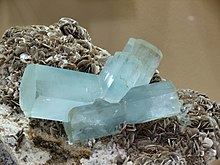| Aquamarine | |
|---|---|
 Aquamarine on muscovite | |
| General | |
| Category | Silicate minerals, beryl variety |
| Formula (repeating unit) | Be3Al2Si6O18 |
| Identification | |
| Color | Pale blue to light green |
| Fracture | Conchoidal |
| Mohs scale hardness | 7.5–8 |
| Streak | White[1] |
| Diaphaneity | Transparent to translucent |
| Specific gravity | 2.65–2.85 |
| Refractive index | 1.57-1.59 |
Aquamarine is a pale-blue to light-green variety of the beryl family,[2] with its name relating to water and sea.[3] The color of aquamarine can be changed by heat, with a goal to enhance its physical appearance (though this practice is frowned upon by collectors and jewelers).[4] It is the birth stone of March.[5]
Aquamarine is a fairly common gemstone,[6] rendering it more accessible for purchase, compared to other gems in the beryl family.[7] Overall, its value is determined by weight, color,[5] cut, and clarity.[8]
It is transparent to translucent and possesses a hexagonal crystal system.[9] Aquamarine mainly forms in granite pegmatites and hydrothermal veins,[10] and it is a very lengthy process that can take millions of years to form.[9]
Aquamarine occurs in many countries over the world, and is most commonly used for jewelry, decoration and its properties.[11]
Aquamarine is mainly extracted through open-pit mining, however underground mining is also a possibility to access aquamarine reserves.[12]
Aquamarine is a durable gemstone, but it highly recommended to conserve it on its own to prevent damage/scratches.[9]
Famous aquamarines include the Dom Pedro, the Roosevelt Aquamarine, the Hirsch Aquamarine, Queen Elizabeth's Tiara, Meghan Markle's ring, and the Schlumberger bow.[13]
- ^ Cite error: The named reference
Schumann 2006 110was invoked but never defined (see the help page). - ^ Manutchehr-Danai, Mohsen (2013-03-09). Dictionary of Gems and Gemology. Springer Science+Business Media. p. 24. ISBN 978-3-662-04288-5.
- ^ Cite error: The named reference
:3was invoked but never defined (see the help page). - ^ Wenk, Hans-Rudolf; Bulakh, Andrei (April 2004). Minerals: Their Constitution and Origin. Cambridge University Press. p. 542. ISBN 978-0-521-52958-7.
- ^ a b "Aquamarine: the blue gemstone and March birthstone". geology.com. Retrieved 2021-08-18.
- ^ Oldershaw, Cally (2003). Firefly Guide to Gems. Firefly Books. p. 124. ISBN 978-1-55297-814-6.
- ^ Oldershaw, Cally (2003). Firefly Guide to Gems. Firefly Books. ISBN 978-1-55297-814-6.
- ^ Cite error: The named reference
:6was invoked but never defined (see the help page). - ^ a b c Cite error: The named reference
:7was invoked but never defined (see the help page). - ^ Cite error: The named reference
:8was invoked but never defined (see the help page). - ^ Cite error: The named reference
:11was invoked but never defined (see the help page). - ^ Cite error: The named reference
:10was invoked but never defined (see the help page). - ^ "Field Museum's "Crane Pacific Expedition" | Classic Chicago Magazine". classicchicagomagazine.com. Retrieved 2024-03-19.